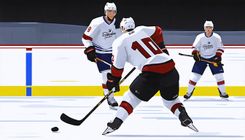NHL CBA Changes: New Development Opportunities for Prospects

The current NHL collective bargaining agreement (CBA) is set to expire in September 2026, a timeline that evokes concern for many who have experienced the sport over the past decade. However, recent developments have brought hope, as ownership and the NHL Players Association reached an agreement on a framework for a new deal this summer. Although the full Memorandum of Understanding has not yet been publicly disclosed, notable changes have emerged, as reported by NHL insider Frank Seravalli.
One of the most significant adjustments stipulated in the new CBA allows each NHL team to assign one 19-year-old prospect to their AHL affiliate each season. This new policy is expected to impact a maximum of 32 players annually. While this may initially appear to have limited scope, it becomes crucial when considering its implications for the development pipeline of NHL prospects. The pathway from prospect to professional player stands to transform dramatically under this new system.
Under the existing CHL-NHL agreement, prospects drafted from one of the Canadian major junior leagues—specifically the OHL, WHL, or QMJHL—cannot be assigned to the AHL or ECHL until they reach 20 years of age or complete four seasons in the CHL. Notably, players selected from other junior leagues and subsequently joining a CHL team are exempt from this rule. Although the updated CBA will not take effect until the 2026-2027 season, its first impacts will be felt by players born in 2007. For instance, Vancouver Canucks prospect Braeden Cootes will turn 19 in February 2026, making him eligible for assignment to the Abbotsford Canucks that fall if the team determines his development would benefit from a change.
The age-based criteria as opposed to draft class designation mean that once the new CBA is active, a player drafted from the CHL, who turns 19 the autumn following their draft, could bypass a return to the CHL altogether. A pertinent case is Ryan Roobroeck, a top prospect eligible for the 2026 draft. As a September 2007 birthday, should Roobroeck sign his entry-level contract immediately and participate in his NHL team's development camp, he may be assigned directly to the AHL, avoiding a return to the Niagara IceDogs of the OHL.
This policy introduces a valuable alternative development pathway for CHL-affiliated prospects, fulfilling a longstanding need. Historically, issues surrounding player development have arisen when elite junior players are unable to advance to the NHL but are also too skilled to return for another season in the CHL. For example, Dylan Strome faced a similar situation a decade ago; his talents far exceeded what the OHL's Erie Otters could offer, yet he was not NHL-ready, which ultimately stunted his progression and contributed to the perception of him as a 'bust.' The opportunity to move directly to the AHL might have positively altered the course of Strome's career.
Recent examples illustrate the effectiveness of this kind of early transition. Cole Perfetti was able to join the Manitoba Moose when the pandemic interrupted his season with the Saginaw Spirit of the OHL in 2021. Similarly, in the 2023-2024 season, Shane Wright received an exception to join the Coachella Valley Firebirds in the AHL after a successful junior career. In both instances, participation at the AHL level proved more beneficial than a return to major juniors or the adverse impact of missing a competitive season altogether.
The specifics of the new CBA indicate that teams can assign only 'one player per organization per season,' which implies that teams will not be able to shift multiple 19-year-olds between their CHL team and AHL on a temporary basis. It is worth noting, however, that such a situation is rare; NHL teams typically possess only one or two 19-year-old prospects capable of necessitating a change in their development trajectory at a time.
This new provision stands as a significant advantage for NHL teams wishing to keep a close watch on their top prospects while also facilitating their growth within a professional environment. Conversely, the constraints on CHL teams may complicate matters for them. The one-player assignment rule may have been influenced, at least partially, by interests from the CHL. Organizations are unlikely to want the loss of their top players, and while NHL teams are limited to one such assignment annually, there remains no specified limit on how many players can be sourced from individual CHL teams.
This change could prove to be a challenge for CHL organizations, particularly given the recent adjustments to the CHL to NCAA transfer regulations. However, a recent executive order concerning NIL (Name, Image, Likeness) regulations could potentially alleviate some of these pressures. The draw of NIL money may be diminished, leading prospects to explore professional routes like the AHL more readily.
With the introduction of this new development pathway, CHL players will no longer face the dilemma of being unprepared for the NHL while simultaneously ineligible to return to junior hockey. Instead, they will have the chance to enter professional ranks a year earlier, allowing them to hone their skills in a competitive environment without reverting to junior leagues, where they may dominate but fail to cultivate adaptability or resolve critical weaknesses.
An example of a CHL team likely to be impacted by these changes is the OHL's London Knights, a franchise known for its strong roster. While the Knights consistently excel at the junior level, the inundation of talent can hinder player development, as they may not face the adversity necessary for growth. Consequently, NHL teams might view this new path as an opportunity to challenge their most promising 19-year-old prospects, promoting quicker advancement into a more demanding setting.
Additionally, there are broader implications tied to this development model. Scott Wheeler, a prospect analyst for The Athletic, noted interactions with multiple agents conveying that many players would opt for the CHL-to-AHL track (which often includes an entry-level contract signing bonus) as opposed to transitioning to the NCAA. This decision is made easier by the fact that many players prefer not to return to an academic setting. A CHL general manager commented that, contingent on the specific CBA language, players may also gain access to arbitration rights a year earlier by choosing the AHL route at age 19, a significant advantage in negotiations with NHL teams.
Ultimately, these unintended consequences may resonate well with players and their agents while presenting a dilemma for NHL franchises. The benefit of an entry-level contract signing bonus for those transitioning from the CHL to the AHL is increasingly appealing, particularly with the uncertainty surrounding current NIL regulations. This trend underscores the push for players to pursue AHL opportunities, which not only guarantees compensation but also keeps them from returning to school, a preference held by many prospective players.









